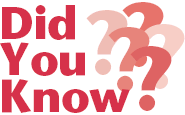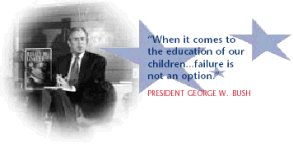 | |||||||||
| |||||||||
|
|||||||||
President Bush Announces 2003 Teacher of the Year
Preventing Summer Reading Loss During Summer Break
Close-Up: No Child Left Behind—Teaching American History
On the Horizon
Opening the Pathways to College Financing
President Bush Announces 2003 Teacher of the Year
President Bush recently named an elementary school teacher from rural Alabama as the 2003 Teacher of the Year during a ceremony in the First Lady's Garden at the White House.
Helen Elizabeth Dawson Rogers, who teaches first and second grades at Leeds Elementary School in Leeds, Ala., was hailed by the president as "an example of the highest professional standards and the finest personal qualities" for her 22 years of service in rural underprivileged schools. Mrs. Bush and Secretary Paige joined the president for the announcement, which also recognized 54 Teachers of the Year from all states and territories.
"When I was campaigning for president, I used to say one of the commitments I would make is to challenge the soft bigotry of low expectations," President Bush said. "You all have challenged the soft bigotry by setting high standards. You believed in the worth of every child. A good teacher believes in the possibilities of every boy and girl. A good teacher sees what is possible, and a good teacher believes in the responsibility of every school to bring out the best in every student."
The complete text of the president's remarks is available at www.ed.gov/Speeches/04-2003/04302003.html.
Preventing Summer Reading Loss During Summer Break
By John Schacter
During summer vacation, children who are economically disadvantaged experience reading achievement declines, while attainment for children from middle- and high-income backgrounds improves. Summer reading loss occurs because disadvantaged children spend their break in neighborhoods that lack academic and culturally enriching resources. They visit few museums, often do not play organized sports and make infrequent trips to the public library. In addition, disadvantaged children are much more likely than their advantaged counterparts to live in households with a scarcity of books, magazines and other print materials. All of these conditions contribute to the fact that summer for disadvantaged children is often an academically and culturally lean time.
For years school districts have sent children to summer school believing that this intervention would result in increased reading and mathematics achievement. Yet, five independent reviews of the research indicate that the effects of summer school on disadvantaged students' achievement levels are negligible. For example, the majority of students attending New York's 2001 summer school programs did not pass their end-of-course exams, and 60 percent failed to improve at all. In Boston, 66 percent of the students required to attend summer school did not post reading or math achievement gains.
| "All of us want to live in a country where our legacy to the world is how we've taken care of our children." —2003 Teacher of the Year, Helen Elizabeth Dawson Rogers, of Leeds, Ala., in her remarks at a White House ceremony in her honor. |
In 2000, the Milken Family Foundation developed an eight-week reading summer day camp intervention where first-grade children who were disadvantaged attended reading camp instead of summer school. Within this summer camp context, credentialed teachers taught children to read for two hours a day, and the remaining five hours were dedicated to "fun." The camp's first-graders played organized sports, swam, and engaged in art, dance and music. Each week, they went on field trips to museums, aquariums and cultural centers throughout Los Angeles. Our results, published in peer-review journals, demonstrate that children who attended the Milken Family Foundation's Read to Achieve Summer Day Camp outperformed control group students by more than 25 percentile points at the end of the summer. More impressive was the fact that they retained this difference one year later. Below are five steps that helped to build our program and can be implemented in schools and communities across America.
1. Implement a research-based reading curriculum. Three large-scale reviews of kindergarten to third-grade reading research have demonstrated that the following five instructional elements lead to increases in young children's reading achievement: (1) explicit phonemic awareness instruction, (2) explicit systematic phonics instruction, (3) guided repeated oral reading, (4) direct and indirect vocabulary instruction, and (5) explicit teaching of comprehension skills.
2. Start early. Most summer school programs across the country start too late in the child's academic career (e.g., third grade). Even the most gifted teachers cannot remediate four years of reading in four to six weeks. Researchers have established that reading interventions during the summers after kindergarten and first grade produce the most successful and lasting results. This finding is especially important because 88 percent of children who are poor readers in first grade will be classified as poor readers in the fourth grade if no intervention is provided.
3. Make summer learning fun. In summer school, children are forced to work for four hours a day on academic tasks that most fail to even grasp during the school year. We showed that changing the learning context from summer school to summer camp could go a long way in changing children's attitudes towards learning and reading achievement.
| Please Note: We will take a break for the summer and resume publication with our Sept. 1, 2003, issue. As we plan for the next school year, we welcome your comments on how we can continue to improve The Achiever to meet your needs. |
4. Intervene for eight weeks instead of four. Most summer schools are four or six weeks. This is too short of a time to develop consistency and make headway with young learners. By introducing an eight-week program, you limit the time disadvantaged children are away from a constructive learning environment. You also allow time for teachers to establish the scope and sequence of skills they want to teach as well as develop performance expectations for each student before they exit.
5. Tutor summer learners the following school year. Do not stop working with students who need it most just because they are back in school. Linking summer reading camp students with volunteer college work-study students or AmeriCorps tutors is a wonderful and extremely inexpensive way to continue to provide reading instruction. Training and monitoring reading tutors to implement effective one-on-one tutoring for one hour per week not only can sustain the summer reading achievement gains but also can improve them.
John Schacter, Ph.D., is vice president of research at the Milken Family Foundation. His research of the Read to Achieve Summer Day Camp was funded by the U.S. Department of Education and the Milken Family Foundation. For a full version of his research, visit www.mff.org.
Close-Up: No Child Left Behind:—Teaching American History
Secretary Paige has announced that nearly $100 million in Teaching American History grants is available and has urged local school districts, including charter school districts, to apply for funding.
The strength of a nation begins in the classroom, and if you cannot read, then you cannot learn history—or grasp what it means to be a citizen," Secretary Paige said at the May 1 We the People Forum on American History, Civics and Service. The forum is part of the Bush administration's ongoing efforts to find ways government can support the teaching of American history and the democratic traditions of the United States. The forum was co-hosted by the U.S. Department of Education, the Corporation for National and Community Service and the National Endowment for the Humanities with the USA Freedom Corps.
 More than half of high school seniors thought that Italy, Germany or Japan was a U.S. ally in World War II. According to a 2001 national sampling of 12th-graders, 24 percent answered "Italy"; 19 percent, "Germany"; 9 percent, "Japan." The other half—48 percent—correctly answered "the Soviet Union. Source: National Center for Education Statistics, The Nation's Report Card: U.S. History 2001. |
The Teaching American History program supports student achievement by improving teachers' knowledge, understanding and appreciation of American history through intensive ongoing professional development.
Statistics show that only 16 percent of fourth-graders, 15 percent of eighth-graders, and 10 percent of 12th-graders scored proficient on U.S. history assessments. In addition, more than half of 12th-grade students did not reach the basic level.
In addition to raising student achievement in history, the program promotes development as a citizen. It is based on the premise that students who know and appreciate American history will be well prepared to understand and exercise their civic rights and responsibilities. The program also focuses on giving teachers strong content knowledge to teach students effectively about the significant issues, episodes, individuals and turning points in the history of the United States.
The program is a direct federal-to-local discretionary grant that funds school districts that partner with institutions with extensive content expertise in American history, such as libraries, museums, nonprofit history or humanities organizations and higher education institutions. Partnerships should develop and carry out programs that promote the teaching of American history as an academic subject separate from social studies.
School districts or charter schools that operate as local education agencies with enrollments of fewer than 300,000 students are eligible for grants ranging from $350,000 to $1 million. School districts with more than 300,000 students are eligible for grants ranging between $500,000 and $2 million.
The Teaching American History application package is in the May 6 Federal Register, which is online at www.ed.gov/legislation/FedRegister/announcements/2003-2/050603b.pdf. The application deadline is July 7.
For more information, contact the Office of Innovation and Improvement at teachingamericanhistory@ed.gov.
On the Horizon
June 17
8:00-9:00 p.m. E.T.
Education News Parents Can Use monthly broadcast will focus on educational technology. Visit www.ed.gov/news/av/video/edtv/index.html or call 1-800-USA-LEARN.
Resource! Opening the Pathways to College Financing
Increased federal education funding combined with record low interest rates for student loans means that the college dream is becoming a reality for more and more students.
The Education Department's Federal Student Aid (FSA) programs are the largest source of financial aid in the nation, providing nearly 70 percent of all student financial aid to cover expenses for eligible programs at participating institutions, including (but not limited to) four-year or two-year colleges or universities, career schools and trade schools. Financial aid can be used to pay for tuition and fees, room and board, books and supplies, and transportation.
The FSA Web site—http://studentaid.ed.gov—offers great fact sheets and brochures on such topics as:
- Stafford Loan Forgiveness for Teachers
- Military Scholarships
- Myths about Financial Aid
- Repaying Your Student Loans
For more information, visit http://studentaid.ed.gov or call 1-800-4-FED-AID (1-800-433-3243). Spanish-speaking customer service representatives are available.
Credits
U.S. Department of Education
The Achiever is published by the Office of Intergovernmental and Interagency Affairs, U.S. Department of Education (ED).
Secretary of Education
Rod Paige
Assistant Secretary
Laurie M. Rich
Senior Director
John McGrath
Executive Editor
Susan Aspey
Editor
Nicole Ashby
Contributing Writer
John Schacter
Designer
Jason Salas Design
Questions or comments:
Editor
The Achiever
U.S. Department of Education
400 Maryland Avenue, S.W.
Room 5E217
Washington, DC 20202
Fax: 202-205-0676
NoChildLeftBehind@ed.gov
Electronic subscriptions and address changes: NoChildLeftBehind@ed.gov
Paper Subscriptions and address changes:
ED Pubs
P.O. Box 1398
Jessup, MD 20794
1-877-4ED-PUBS (433-7827)
edpubs@inet.ed.gov Information on ED programs, resources and events:
Information Resource Center
U.S. Department of Education
400 Maryland Avenue, S.W.
Washington, DC 20202
1-800-USA-LEARN (872-5327)
usa_learn@ed.gov www.ed.gov/about/offices/list/oiia/irc The Achiever contains news and information about public and private organizations for the reader's information. Inclusion does not constitute an endorsement by the U.S. Department of Education of any products or services offered or views expressed.
Unsubscribe
To unsubscribe from The Achiever:
- Send email to listproc@inet.ed.gov
- Write in the body of the message: unsub nochildleftbehind

|
|
|
|||||||||||
| |
||||||||||||
Last Modified: 11/06/2006

